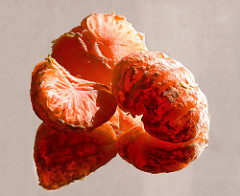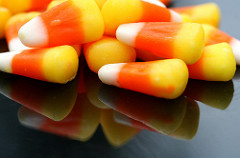I try to take pictures every day. Some days, of course, I’m inspired by something I see. At other times, I need to inspire myself and come up with an idea. This week, an idea was prompted by discovering an old discarded medicine cabinet that had mirrored doors. The doors were removable and provided me with two relatively large rectangles of mirrored glass.
One day, I decided to play with the mirrors, and it certainly was fun. First, I washed them to eliminate distracting blotches and spots. Then I tried laying various objects on them. I found that some objects are pretty boring on a mirror. For example, most thin flat objects do not produce interesting reflections. All you see are the edges. Plump or rounded objects reveal more of their undersides. If the underside is a different color from the top side, you can get interesting images. Although you can create the appearance of reflections using software, you will have far more fun experimenting with real ones.

Irregularly shaped objects make the most interesting reflections, I think. It’s hard to tell where the object ends and its reflection begins. I set a half-peeled clementine on the mirror and was tickled by the result; later, I piled the segments on the mirror and liked those results as well.
A few warnings. Be aware of what is above your item, because that will reflect in the mirror and provide the background. Often, by changing your position, you can change what appears in the mirror. If the mirror is near a window, for example, you can often move so that the outside sky reflects in the mirror. Move another way, and the ceiling of your room becomes the background. Pay no attention at all, and you may wind up with a confusing mixture of lines and angles. Also, be careful about very bright lights. They can create glare spots. Soft light and sidelight work well.

Your mirror need not be a sheet of glass. It could be a shiny plastic tray, like the one used below the candy corn shown here. It could also be a piece of aluminum foil, painted or polished metal, or any other reflective surface.
Start by finding one or more reflective surfaces, as well as a light source. Then play. Pile on different types of items. I happen to like food, but jewelry, game pieces, hardware, or other small items would also work well. Try different arrangements, and try different reflective surfaces. Remember that photography can be fun as well as challenging.









As this image shows, rotating the resulting image can sometimes produce a stronger and more abstract image. Transparent or translucent objects with interior detail create very interesting reflections too.
What a nice effect. Sounds like the perfect indoor project for a rainy day!
Good idea, Steve–thanks. And Anthea, you’re right…it IS a perfect rainy day project, as long as you have enough light.